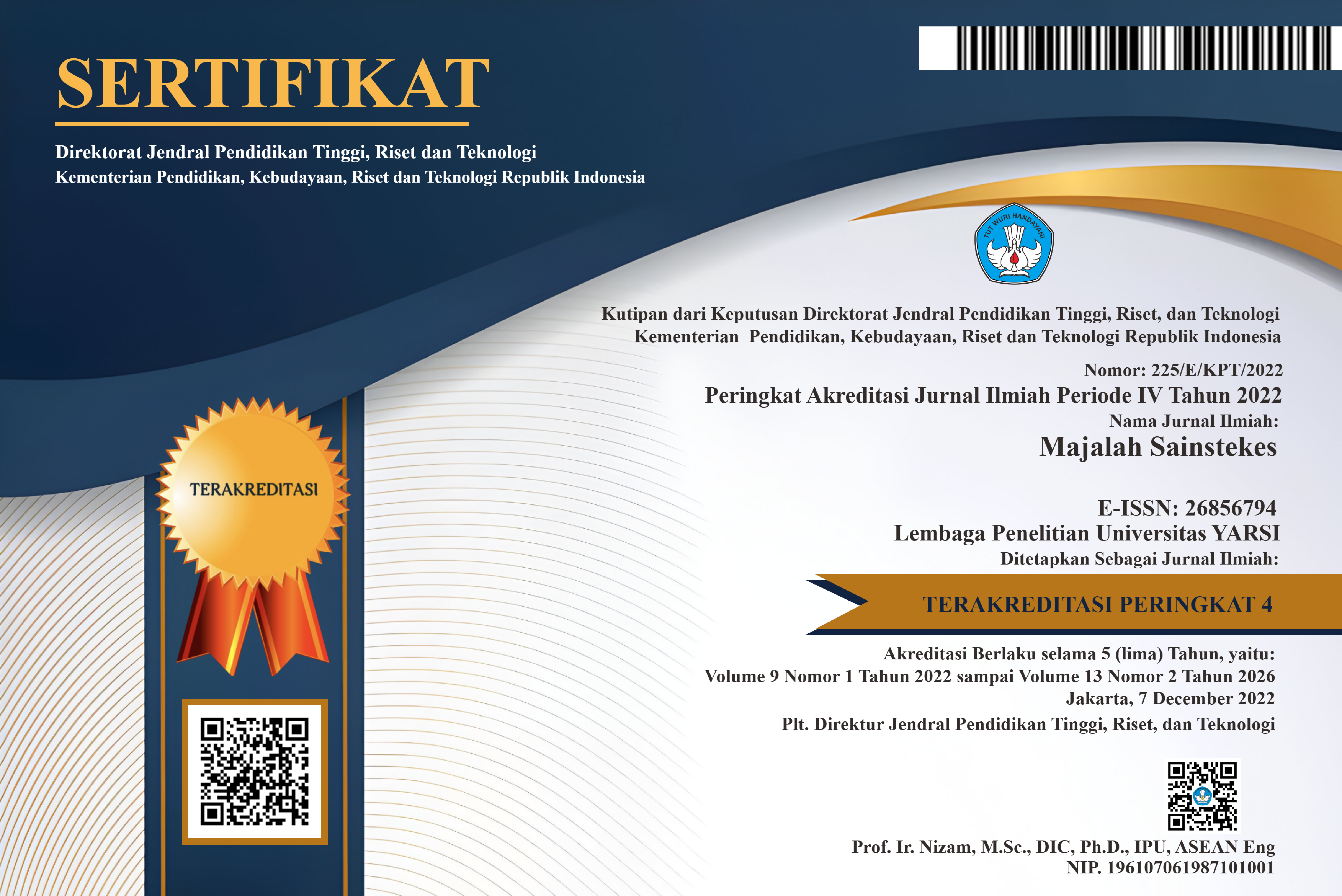IDENTIFIKASI FAKTOR RISIKO TERJADINYA KOLONISASI SPESIES CANDIDA DI RONGGA MULUT PADA INDIVIDU SEHAT (PENELITIAN PADA MAHASISWA & MAHASISWI FKG UI)
Keywords:
Candida, risk factors, the oral cavity.Abstract
Introduction : Cases of oral candidiasis are commonly found, both in healthy individuals and immunecompromise patients, however publications of Candida carrier in the oral cavity of healthy population and risk factors for colonization in Indonesia are hardly available. Objective : This study was aimed to analyze the type and number of Candida colonies and identify risk factors in the oral cavity of apparenthly health FKG UI students. Material and methods : the specimens were taken from 195 subjects with oral rinse technique for identification using culture medium CHROMagar® and Sabaraoud dextrose agar. Results and discussion : Candida species were found in the 107 subjects oral cavity (54.87%), being Candida albicans was is the predominant species (52.33%). Some 88 subjects (82.24%) was dominant in the number of colonies less than 400 CFU/ml, while the rest had colony of more than 400 CFU/ml (17.76%). Candida colony grew dominantly in single colony (90.65%), and the others showed multi-species colonies (9.34%). Risk factors identified included age; gender; hormonal; blood type O; denture; orthodontic appliances; unstimulated salivary flow; pH of saliva; smoking, alcohol and oral cleaning habit; and oral health status. By using a statistical Pearson chi-square test, no significant relationship was found between risk factors and number of Candida colonies in the oral cavity p less than 0.05. Conclusion : there was no one single risk factor for Candida colonization, but combination of various risk factors for demographis, local and systemic was observedReferences
Abraham C 2011. Advances and emerging techniques in the identification, diagnosis and treatment of oral candidiasis. The Open pathol J; 5: 8-12.
Al-Karaawi Z, Manfredi M, Waugh A, et al 2002. Molecular characterization of Candida spp. isolated from the oral cavities of patients from diverse clinical settings. Oral Microbiol & Immunology; 17(1): 44-49.
Bustan MN 2008. Epidemiologi penyakit tidak menular. Jakarta : Penerbit PT Rineka Cipta,.
Depkes RI 2005. Rencana pembangunan jangka panjang kesehatan 2005-2025. Diunduh tanggal 26 Juli 2012.
Epstein J et al 1980. Quantitative relationship between candida albicans in saliva and the clinical status of human subjects. J of clin microbiol; p475-6.
Ghannoum M et al 2010. Characterization of the oral fungal microbiome (Mycobiome) in healthy individuals. Plos Pathog; 6(1).
Greenberg MS, Glick M 2008. Diagnosis and treatment. 11th ed. BC Decker Inc.
Hannula J, Saarela M, Jousimies-Somer H, et al 1999. Age-related acquisition of oral and nasopharyngeal yeast species and stability of colonization in young children. Oral Microbiol and Immunology; 14(3): 176-182.
Hasslof P et al 2010. Growth inhibition of oral mutans streptococci and candida by commercial probiotic lactobacilli-an in vitro study. BMC Oral Health; 10: 18.
Karibasappa GN et al 2011. Assesment of microbial contamination of toothbrush head: An in vitro study. India J of Dent Res; 22 (1): 2-5.
Marsh P & Martin M 2009. Oral Microbiology. Edinburgh : Elsevier.
Martins ACM, et al 2011. Prevalence of yeast species in the oral cavity and its relationship to dental caries. Acta Scientiarum Health Sci; 33(1): 107-12.
Meurman JH, et al 2007. Non candida albicans candida yeasts of the oral cavity. Communicating current research and educational topics and treands in applied microbiology. Formatex; p719-31.
Ollila P, Larmas M 2008. Long-term predictive value of salivary microbial diagnostic tests in children. Eur Archives Of Paediatric Dent; 9(1): 25-30.
Rindum J, Stenderup A, Holmstrup P 1994. Identification of Candida albicans types related to healthy and pathological oral mucosa. J of Oral Pathol & Med; 23(9): 406-412.
Samaranayake L 2009. Commensal oral candida in asian cohorts. Inter J of Oral Science; 1(1): 2-5.
Stalker P 2008. Millenium development goals. WHO,. Diunduh tanggal 26 Juli 2012.
Torres SR et al 2002. Relationship between salivary flow rates and Candida counts in subjects with xerostomia. Oral Surg Oral Med Oral Pathol Oral Radiol Endod; 93:149-54.
Uygun-Can B, Kadir T, Akyuz S 2007. Oral candidal carriage in children with and without dental caries. Quintessence Inter; 38(1): 45-49.
Van Wyk C, Steenkamp V 2011. Host factors affecting oral candidiasis. Southern African J of Epidemiology & Infection; 26(1): 18-21.
Xu J & Mitchell TG 2003. Geographical differences in human oral yeast flora. Clinical Infectious Dis; 36: 221-4.
Zadik Y, Burnstein S, Derazne E, et al 2010. Colonization of Candida: prevalence among tongue-pierced and non-pierced immunocompetent adults. Oral Dis; 16(2): 172-175.

 Audiawati Audiawati
Audiawati Audiawati












